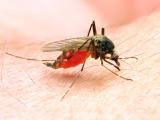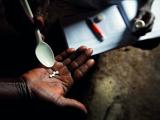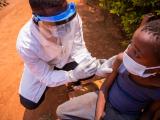Sep 3, 2010 (CIDRAP News) An experimental malaria drug that has a different mechanism from older drugs cured laboratory mice with a single dose, raising hope for eventually providing a powerful new weapon against the disease in humans.
In test-tube experiments, the drug, called NITD609, killed both species of malaria parasites, Plasmodium falciparum and P vivax, and was effective against drug-resistant strains, according to a report published in today's issue of Science. The compound attacks malaria parasites in their bloodstream stage by blocking protein synthesis, according to the report.
The study was led by Thierry T. Diagana, PhD, of the Novartis Institute for Tropical Diseases (NITD), and Elizabeth A. Winzeler, PhD, of the Scripps Research Institute and the Genomic Institute of the Novartis Research Foundation in La Jolla, Calif.
"The compound developed by Dr. Winzeler and her colleagues appears to target a parasite protein not attacked by any existing malaria drug, and has several other desirable features," said Dr. Anthony S. Fauci, director of the National Institute of Allergy and Infectious Diseases (NIAID), one of the study's sponsors, commenting in an NIAID press release.
The researchers identified what became NITD609 by sifting 12,000 chemicals using "an ultra-high throughput robotic screening technique" to identify compounds active against P falciparum, according to the NIAID statement. "Medicinal chemists at the NITD then synthesized and evaluated about 200 versions of the original compound to arrive at NITD609, which could be formulated as a tablet and manufactured in large quantities," the NIAID said. The drug is one of a new class of compounds called spiroindolones.
Test-tube studies showed that the compound, besides killing both P falciparum and P vivax, worked faster than some older malaria drugs, though not as fast as artemisinin, the best current treatment, the NIAID reported.
The compound was tested in mice infected with the mouse version of malaria, P berghei, which usually kills mice within a week. A single large dose of NITD609 cured all five mice that received it (meaning the parasite was absent after 30 days), and 3 of 6 mice that received half as large a dose also were cured, according to the Science report. Three doses of the smaller amount increased the cure rate to 90%.
For comparison, infected mice were also treated with four other existing malaria drugs, none of which effected a cure within 30 days, the report says.
In the NIAID statement, Winzeler said it might be possible to develop NITD609 into a drug that could be taken just once, as compared with current regimens involving 3 to 7 days of treatment. Also, she said the use of fewer doses reduces the parasite's opportunities to develop resistance.
The scientists also investigated how malaria might develop resistance to the drug, by exposing parasites to sublethal doses for several months, until resistant strains emerged, the NIAID said. They analyzed the resistant strains and determined that resistance results from a change in a gene that encodes a protein called PfATP4, which allows substances to cross cell membranes. If NITD609 eventually is used as a human drug, this information will allow scientists to quickly detect resistant strains in clinical use, Winzeler said.
In a commentary in Science, Timothy N.C. Wells of Medicines for Malaria Ventures, a Geneva-based organization, said the new findings are timely in view of recent reports from Cambodia of the first signs of resistance to artemisinin, "the essential ingredient of existing malaria treatments for 100 million people annually."
Wells said it is reassuring that the researchers had trouble producing parasites resistant to NITD609 and that the compound is active against malaria strains from Thailand, where resistance to artemisinin is a growing problem.
But he said only time will tell if the new compound can replace artemisinin. "In vitro and animal data are often poor surrogates for clinical reality," he observed. "Even the most optimistic observer would note that less than 20% of new compounds make it to final approval, and that the process can take up to 8 years."
In the NIAID statement, Winzeler said additional testing of NITD609 in animals is under way, and safety testing in humans could begin later this year.
See also:
Sep 3 Science abstract
http://www.sciencemag.org/cgi/content/abstract/329/5996/1175
Sep 2 NIAID press release
http://www.niaid.nih.gov/news/newsreleases/2010/Pages/malariaDrug.aspx
Sep 3 Science commentary extract
http://www.sciencemag.org/cgi/content/summary/329/5996/1153


















